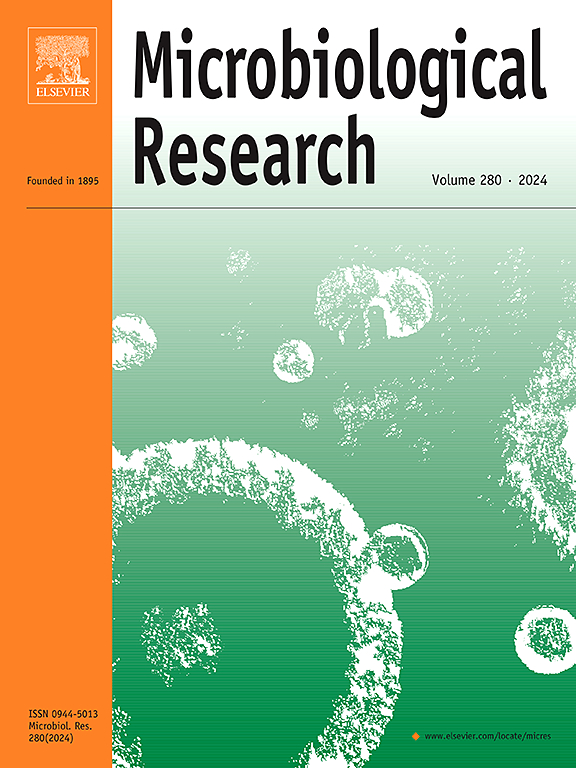Brassinosteroids mediate arbuscular mycorrhizal symbiosis through multiple potential pathways and partial identification in tomato
IF 6.1
1区 生物学
Q1 MICROBIOLOGY
引用次数: 0
Abstract
Currently, little is known regarding the specific processes through which brassinosteroids (BR) affect arbuscular mycorrhizal (AM) symbiosis. Understanding this relationship is vital for advancing plant physiology and agricultural applications. In this study, we aimed to elucidate the regulatory mechanisms of BR in AM symbiosis. According to the log2 fold change-value and adjP-value, we integrated the common differentially expressed genes (DEGs) in maize (Zea mays L.) treated with BR and AM, Arabidopsis (Arabidopsis thaliana) mutants deficient in BR receptors, and tomato (Solanum lycopersicum) plants inoculated with AM fungi. In addition, we characterized the symbiotic performance of tomato plants with BR receptor defects and overexpression. The results indicated that the common differential genes induced by BR and AM were involved in metabolic processes, such as cell wall modification, cytoskeleton remodeling, auxin and ethylene signaling, photosynthesis, mineral nutrient transport, and stress defense. Specifically, these include the BR1 gene, which modifies the cell wall. However, the fungal colonization rate of BR receptor-deficient tomato plants was significantly reduced, and the total phosphorus concentration was increased. Conversely, the performance of the overexpressing tomato transformation plants demonstrated a significant contrast. Additionally, the mild rescue of mycorrhizal attenuation in mutants treated with exogenous BR suggests the possibility of direct feedback from BR synthesis to AM. Notably, the cell wall modification gene (SlBR1) and calcium spike gene (SlIPD3) were induced by both BR and AM, suggesting that BR may influence cell penetration during the early stages of AM colonization. Synthesis: Our results demonstrated that BR positively regulates AM symbiosis through multiple pathways. These findings pave the way for future research, including isolation of the individual contributions of each pathway to this complex process and exploration of possible agricultural applications.
芸苔素类固醇通过多种潜在途径介导丛枝菌根共生,并在番茄中进行了部分鉴定
目前,人们对铜绿素类固醇(BR)影响丛枝菌根(AM)共生的具体过程知之甚少。了解这种关系对于促进植物生理学和农业应用至关重要。在本研究中,我们旨在阐明 BR 在 AM 共生中的调控机制。根据对折变化值(log2 fold change-value)和P值(adjP-value),我们整合了经BR和AM处理的玉米(Zea mays L.)、缺乏BR受体的拟南芥(Arabidopsis thaliana)突变体以及接种了AM真菌的番茄(Solanum lycopersicum)植株中常见的差异表达基因(DEGs)。此外,我们还研究了BR受体缺陷和过表达的番茄植株的共生表现。结果表明,BR和AM诱导的共同差异基因参与了代谢过程,如细胞壁修饰、细胞骨架重塑、辅助素和乙烯信号转导、光合作用、矿质养分运输和胁迫防御。具体来说,其中包括改造细胞壁的 BR1 基因。然而,BR 受体缺陷番茄植株的真菌定植率显著降低,总磷浓度增加。相反,过表达番茄转化植株的表现却呈现出明显的反差。此外,用外源 BR 处理的突变体对菌根衰减的轻度挽救表明,可能存在从 BR 合成到 AM 的直接反馈。值得注意的是,细胞壁修饰基因(SlBR1)和钙穗基因(SlIPD3)同时被BR和AM诱导,这表明BR可能会在AM定殖的早期阶段影响细胞渗透。综述:我们的研究结果表明,BR 通过多种途径积极调控 AM 的共生。这些发现为今后的研究铺平了道路,包括分离出每种途径对这一复杂过程的贡献,以及探索可能的农业应用。
本文章由计算机程序翻译,如有差异,请以英文原文为准。
求助全文
约1分钟内获得全文
求助全文
来源期刊

Microbiological research
生物-微生物学
CiteScore
10.90
自引率
6.00%
发文量
249
审稿时长
29 days
期刊介绍:
Microbiological Research is devoted to publishing reports on prokaryotic and eukaryotic microorganisms such as yeasts, fungi, bacteria, archaea, and protozoa. Research on interactions between pathogenic microorganisms and their environment or hosts are also covered.
 求助内容:
求助内容: 应助结果提醒方式:
应助结果提醒方式:


